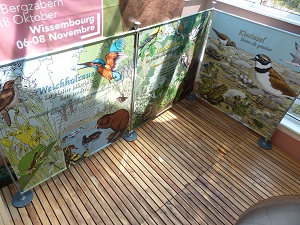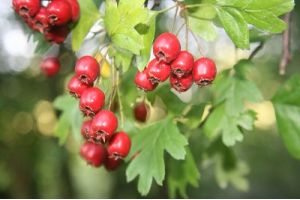Nature
Noah’s ark on the doorstep of the Rhineland town
The Sauer Delta, prestigious area, is renowned for its important natural wealth. Its fauna and flora, typical of damp areas, flourish in Rhineland forests, reed beds and floodplains. There are numerous species of birds, mammals, batrachians, fish and plants, some rare, to discover.
The nature initiation center
A world of nature to explore on your doorstep!
Comprising professional naturalists and volunteer nature guides, the Nature Center has been endorsed as a “Center for the Introduction to Nature and the Environment” (CINE). In addition to its educational work with school children, it also works with the general public to introduce them to the countless riches of the landscape and the flora and fauna to be found in its territory. From the Northern Vosges to the Rhine, from Le Bienwald to the outskirts of Strasbourg, the Nature Center is our guide to information on and exploration of the living world that surrounds us.
 In addition to the activities of the “General Public” and “Schools” programmes, the CINE is able to propose activities according to your more specific requests and interests.
In addition to the activities of the “General Public” and “Schools” programmes, the CINE is able to propose activities according to your more specific requests and interests.
For more information:
67470 MUNCHHAUSEN
The nature reserve
The nature reserve of the delta of the Sauer is part of the river forest of Alsace and contains a remarkable mosaic of natural habitats, which the ornithological station.
On land there are:
 A mix of forest sites showing the different stages of the evolution of the alluvial forest environment from fast growing pioneer forests of soft wood made up mainly of White Willow, to the final hard wood forest of hard wood made up of pedonculate or English oak, ash, elm
A mix of forest sites showing the different stages of the evolution of the alluvial forest environment from fast growing pioneer forests of soft wood made up mainly of White Willow, to the final hard wood forest of hard wood made up of pedonculate or English oak, ash, elm- plantations of hybrid poplars
- meadows, mainly in the Grosswoerth, where big reed beds cover the most humid ground
 "Euphorbia palustris"
"Euphorbia palustris"
Aquatic areas :
- The Sauer and its different branches more or less connected to each other depending on the water level.
- Gravel pits excavated more recently.
Between these two distinct important types of environment there are mudflats that vary in size according to water level during flooding.
 Willow forest
Willow forest
These different natural habitats are hosts to rich and varied flora and fauna with a survey revealing 400 different plants, 182 types of bird, 34 varieties of dragon fly, and 20 types of fish.
Surprise yourself exploring these different zones and their exceptional natural assets alone or with a guided tour organised by the site manager.

For more Information :
Conservatoire des Sites Alsaciens
Antenne du Bas-Rhin
1, rue des écoles – 67850 OFFENDORF
Tél. 03 89 83 34 10 – Fax 03 88 59 77 01
www. conservatoire-sites-alsaciens.eu
Our Rhine forests
The Rhine forests of the canton form a curtain of greenery round Seltz. Not far away, Celtic holy places, the forests of Seltz and Niederroedern, as well as the Bois de l’Hôpital (Hospital Wood) at Kesseldorf are ideal places for long walks. In the heart of the valley, the Seltzbach murmurs through woodland to rejoin the river Sauer which threads its way (along the former Rhine riverbed) from Seltz to Munchhausen.

Along with the forests of Mothern and Beinheim, these forests form a veritable eco-corridor, a sanctuary conducive to wildlife and, more particularly, to wetland-dependent species (ducks, waders, amphibians, etc.). These forest spaces are now managed to safeguard this natural heritage and enable the attentive rambler to discover there richness... The high point of these remarkable areas, the Sauer Delta Nature Reserve, where the visitor can explore a patchwork of reed beds, alluvial forests, water meadows... In this protected environment, he can delve back into the Rhineland landscapes of earlier times and picture the work of the fishermen of yore aboard their flat-bottomed boats.
Another natural curiosity awaits the rambler: the Lower Rhine willow, the emblematic tree of the Rhine forests. As the result of the regular pruning which once provided the raw material for making clogs, baskets and wicker fish traps, trees in phantasmagorical shapes inhabit these forests, sculpted over the generations. Some wonderful specimens can be seen in the municipal forest of Mothern.
A rich fauna and flora
Regarding the fauna, one can find rare amphibians such as the brown toad or the green tree fog. Bird life is also abundant with perching birds such as the blue throat, warblers (reed warblers for example).

In the delta in winter there are water birds of passage such as winter teal, pintail ducks or the rarer smew or certain waders such as the Great White Egret. Regarding the flora, one can recognise such rare and protected plants as the violet. Euphorbia, several orchids, Epipactis helleborus among others, and also the creepers which have carned the Rhine forest its nickname of “jungle”. But other sites such as the Woert of Seltz merit a detour. This former loop of the Rhine is home to a remarkable combination of vegetation. One can find dry-habitat flora such as brome and hawthorn not to mention orchids. These habitats are very interesting from an ecological point of view.
Backwater of the Rhine
In former days the Rhine used to flow in large loops which would move from one year to another. After the river was regulated different biotopes developed in numerous dead branches. The Aspenkopf at Beinheim is one of them. With time it stilted up and began to lose its richness of flora, fauna and fish. A major restoration programme has created a flow of water from the Rhine, unsilting the main bed and unplugging water table springs. In creating a current and subjecting the sector to repeated influences of variations in the river, man has revived the biotope much to the joy of not only naturalists, but also of its inhabitants – the animals, fish and plants.
Seltz
|The Beekeepers’ Association of the Canton of Seltz will show you the world of bees.
Visits must be booked in advance.
What do we know about bees? How do they live? How many worker bees, queens and drones are there in a hive? What is the role of each of them in the hive? How do they grow up? What are the different products of the hive other than honey? What use are they to the bees? What use are they to us? … A lot of questions that the beekeeper will answer with enthusiasm.
Munchhausen
Considering the willow and reed plantations as well as the mud flats, the Delta de la Sauer nature reservation provides a complete change of scene.
Created on ministerial order in 1997 it is composed of 486 ha of protected land.
This beauty spot for ornithology, botany, hydrology or just for its landscapes is also one of the last areas where the flood of the Rhine can spread.
Munchhausen
It is situated at the point where the Sauer joins the Rhine. It is a one-off construction in Europe as it is a flap gate that rests on the water outside flood periods. When raised vertically, it acts as a dyke during high water periods. The construction is 60 m long and 7 m high and it can be moved using hydraulic jacks, each with a thrust of 350 tonnes.
Seltz
A botanical garden laid out in play and picnic areas. You can see numerous species of trees.
Munchhausen
A world of nature to explore on your doorstep!
Comprising professional naturalists and volunteer nature guides, the Nature Centre has been endorsed as a “Centre for the Introduction to Nature and the Environment” (CINE). In addition to its educational work with school children, it also works with the general public to introduce them to the countless riches of the landscape and the flora and fauna to be found in its territory.
From the Northern Vosges to the Rhine, from Le Bienwald to the outskirts of Strasbourg, the Nature Centre is our guide to information on and exploration of the living world that surrounds us.
In addition to the activities of the “General Public” and “Schools” programmes, the CINE is able to propose activities according to your more specific requests and interests.
Lauterbourg
Begins downstream of the water gate on the principal structure and ends upstream, at the edge of the discharge weir. This structure comprises 10 pools of 1.50 x 2.80 m and is designed to help fish swim up river.
A practically identical structure has been made in the Berizzi Mill sector at Berg (Palatinate).
Beinheim
The heronry, a sublimely beautiful biotope on an islet in the middle of the gravel pit with its remarkable reed bed and its natural spawning ground, is home to a few pairs of herons, black kites, great spotted woodpeckers and other Rhineland residents.
Munchhausen
the nature reserve site in Munchhausen is open to anyone curious about or interested in the practice of bird ringing.
Group outing for all ages (mid Juli to the end of September) on appointment.
Beinheim
Take advantage of the magic and the calm you have in the ephemeral garden : you can recharge your batteries, relax or read books in this green setting, where art and nature are meeting.
Beinheim
The home of Baron Jean Adam Schramm (1760-1826), a native of Beinheim who was to become an Imperial General, now houses the local authority offices. With the passage of time, its former garden had withered away. In line with a policy to promote the area's heritage, it has been replaced by a botanical garden designed by the landscape designer Agnès Daval: in a limited area are symmetrical beds of rich collections of native plants typical of the Rhine valley and perennials, including glorious peonies and roses from the beginning of the 19th century; extending into the distance is a generous grassy meadow embellished with a gazebo and lined with hedges of shrubs.
